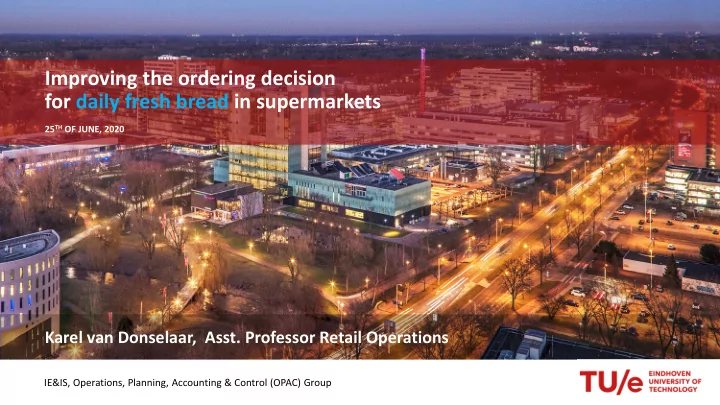

Improving the ordering decision for daily fresh bread in supermarkets 25 TH OF JUNE, 2020 Karel van Donselaar, Asst. Professor Retail Operations IE&IS, Operations, Planning, Accounting & Control (OPAC) Group
Current situation • Supermarket chain with multiple stores • Bread is 1 day fresh • Ordering once per day at external bakery • Fixed case pack sizes • Some SKUs are dedicated as ‘NOOS’ (never out-of-stock) • Company-wide norms for %Waste (at category level) Goal: identify and evaluate improvement options for the current Automated Store Ordering system 2 Improving the ordering decision for daily fresh bread in supermarkets
Improvement options 1. More advanced ordering logic 2. Allowing ordering per piece 3 Improving the ordering decision for daily fresh bread in supermarkets
Improvement option 1: More advanced ordering The objective of the company for fresh bread is: Maximise sales revenue subject to a maximum %waste, i.e. total waste should not exceed a given target (e.g. 5% of demand for the total product category) Three models were tested to solve this problem: Model 1: assume demand is known and include case pack sizes in model Model 2: assume demand is uncertain and in 1 st step ignore case pack sizes Model 3: assume demand is uncertain and include case pack sizes in model Model 2 is a variation of the simple Newsboy model and Model 3 is a binary linear program 4 Improving the ordering decision for daily fresh bread in supermarkets
Results: 1. More advanced ordering • Efficient Frontiers for bread department per supermarket allow informed choice %Waste and Revenue (e.g. small supermarkets should have higher %waste targets) • Model 3 performs best; benefits: 1%-5% higher revenue 5 Improving the ordering decision for daily fresh bread in supermarkets
Results: 2. Allow ordering per piece • Allowing ordering per piece increases improvement potential of advanced ordering model (model 3) Figure 5: Effect case pack size on efficient frontiers: demand uncertain and fixed case pack sizes (model 3), demand uncertain and ordering per piece (model 3b), and the current model (model 4) 6 Improving the ordering decision for daily fresh bread in supermarkets
Conclusion • An Efficient Frontier for every bread department can be created if Advanced ordering is used. This allows to make an informed choice on targets for %Waste and Revenue per store. • More advanced ordering gives 1%-5% extra revenue • 7% extra revenue by applying advanced ordering and ordering per piece • Trade-off between improvement potential, increased purchasing costs(due to ordering per piece) and added complexity is required 7 Improving the ordering decision for daily fresh bread in supermarkets
Recommend
More recommend